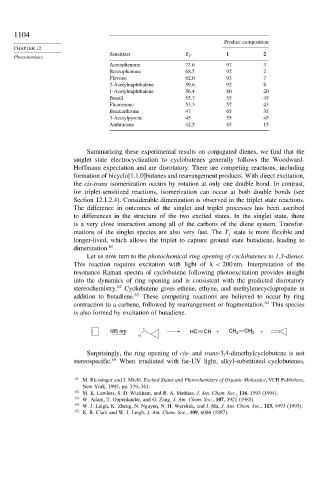Page 1119 - Advanced Organic Chemistry Part A - Structure and Mechanisms, 5th ed (2007) - Carey _ Sundberg
P. 1119
1104
Product composition
CHAPTER 12
Sensitizer 1 2
Photochemistry E T
Acetophenone 73.6 97 3
Benzophenone 68.5 92 2
Flavone 62.0 93 7
2-Acetylnaphthalene 59.6 92 8
1-Acetylnaphthalene 56.4 80 20
Benzil 53.7 55 45
Fluorenone 53.3 57 43
Benzanthrone 47 65 35
3-Acetylpyrene 45 55 45
Anthracene 42.5 85 15
Summarizing these experimental results on conjugated dienes, we find that the
singlet state electrocyclization to cyclobutenes generally follows the Woodward-
Hoffmann expectation and are disrotatory. There are competing reactions, including
formation of bicyclo[1.1.0]butanes and rearrangement products. With direct excitation,
the cis-trans isomerization occurs by rotation at only one double bond. In contrast,
for triplet-sensitized reactions, isomerization can occur at both double bonds (see
Section 12.1.2.4). Considerable dimerization is observed in the triplet state reactions.
The difference in outcomes of the singlet and triplet processes has been ascribed
to differences in the structure of the two excited states. In the singlet state, there
is a very close interaction among all of the carbons of the diene system. Transfor-
mations of the singlet species are also very fast. The T state is more flexible and
1
longer-lived, which allows the triplet to capture ground state butadiene, leading to
dimerization. 61
Let us now turn to the photochemical ring opening of cyclobutenes to 1,3-dienes.
This reaction requires excitation with light of < 200nm. Interpretation of the
resonance Raman spectra of cyclobutene following photoexcitation provides insight
into the dynamics of ring opening and is consistent with the predicted disrotatory
stereochemistry. 62 Cyclobutene gives ethene, ethyne, and methylenecyclopropane in
addition to butadiene. 63 These competing reactions are believed to occur by ring
contraction to a carbene, followed by rearrangement or fragmentation. 64 This species
is also formed by excitation of butadiene.
..
185 nm HC CH + CH 2 CH 2 +
H
Surprisingly, the ring opening of cis- and trans-3,4-dimethylcyclobutene is not
stereospecific. 65 When irradiated with far-UV light, alkyl-substituted cyclobutenes,
61
M. Klessinger and J. Michl, Excited States and Photochemistry of Organic Molecules, VCH Publishers,
New York, 1995, pp. 339–341.
62
M. K. Lawless, S. D. Wickham, and R. A. Mathies, J. Am. Chem. Soc., 116, 1593 (1994).
63 W. Adam, T. Oppenlander, and G. Zang, J. Am. Chem. Soc., 107, 3921 (1985).
64 W. J. Leigh, K. Zheng, N. Nguyen, N. H. Werstiuk, and J. Ma, J. Am. Chem. Soc., 113, 4993 (1993).
65
K. B. Clark and W. J. Leigh, J. Am. Chem. Soc., 109, 6086 (1987).

